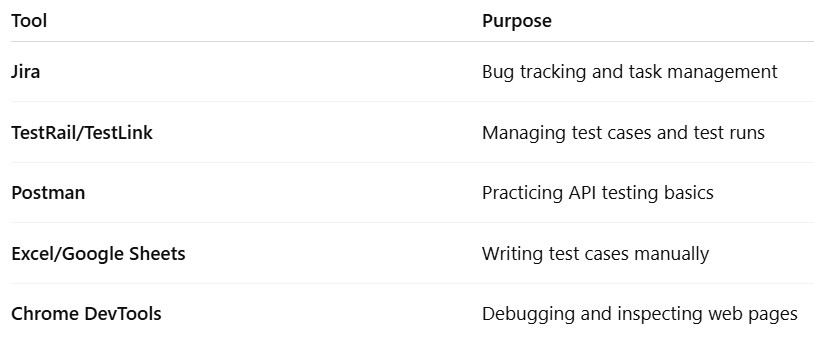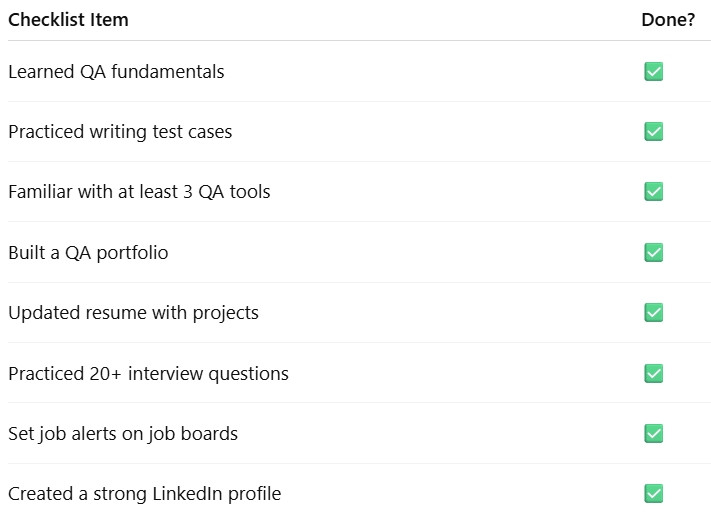 INTERVIEW QUESTIONS
INTERVIEW QUESTIONS How to Land Your First Software Quality Assurance Job

Breaking into the world of software testing was one of the most rewarding decisions of my career. When I first decided to explore a career in Quality Assurance (QA), I had no degree in computer science and barely understood how software development worked. Yet, today I work as a full-time QA professional, and I’ve helped others make this same journey.
If you’re wondering how to land your first software quality assurance job, this guide is for you. I’ll share every step I took, what I learned along the way, and how you can stand out—even with no prior experience.
I. Understanding the QA Role
Before applying for jobs, I had to understand what QA professionals actually do. It’s more than just "finding bugs." As a QA tester, your job is to ensure that the software works as intended, is free from defects, and delivers a quality user experience.
Core QA Responsibilities:
- Reviewing requirements and understanding business logic
- Writing and executing test cases
- Reporting bugs using tools like Jira
- Retesting fixes and doing regression testing
- Collaborating with developers and product managers
There are two primary types of QA:
- Manual QA: where tests are performed by hand
- Automation QA: where tests are written in code and run automatically
As a beginner, I focused on manual testing because it built a strong foundation.
II. Building a Strong QA Foundation
I started with zero technical background, so my first goal was to understand the basics.
Key Concepts I Focused On:
- Types of Testing: Functional, Regression, Integration, Smoke, and Sanity Testing
- STLC (Software Testing Life Cycle)
- Test Case design techniques: boundary value, equivalence partitioning
- Bug Lifecycle and Reporting
I took notes, practiced writing test cases on simple applications, and kept everything documented. Understanding the theory gave me confidence, but I knew I needed practice.
III. Practicing Without a Job
This was a game-changer. Instead of waiting for someone to “give me experience,” I created it myself.
Here’s What I Did:
- Tested Open-Source Web Apps: I used websites like WordPress and TodoMVC to write test cases, report bugs, and even suggest fixes.
- Practiced on Demo Sites: There are many dummy e-commerce or banking apps made for testing practice.
- Logged My Work: I created a personal Google Drive folder where I documented test cases, bug reports, and screenshots.
- Built a QA Portfolio: This was key. My portfolio helped prove that I knew what I was doing, even without official job experience.
IV. Learning Entry-Level QA Tools
Understanding tools is a big part of landing a job in QA. I didn’t learn everything at once—instead, I focused on a few beginner-friendly ones.
Tools I Used:

Even just basic familiarity with these tools put me ahead of many other applicants.
V. Creating a Job-Ready QA Resume and Portfolio
Your resume is your first impression—make it count. Here's how I structured mine:
Resume Tips:
- Clear headline: “Aspiring QA Tester with Hands-on Project Experience”
- Projects Section: Listed 3–4 real projects I worked on independently
- Skills Section: Mentioned tools (Jira, TestRail, Postman), and methodologies
- Certifications: I added short online courses I completed
- No Fluff: I kept the resume clean, to-the-point, and honest
My Portfolio Included:
- 2–3 testing project reports (test cases, bug reports)
- Screenshots and short videos of my testing
- Links to GitHub where I stored documents
This gave hiring managers proof of my ability—something that goes a long way when you don’t have formal experience.
VI. Preparing for QA Interviews
Interviews can feel intimidating, but preparation makes all the difference.
Common QA Interview Questions I Faced:
- “What is the difference between smoke and sanity testing?”
- “How do you write a good bug report?”
- “How would you test a login page?”
- “What would you do if the developer says it's not a bug?”
My Interview Prep Strategy:
- Practiced answers to 20+ common manual testing questions
- Used the STAR method for behavioral questions
- Conducted mock interviews with friends
- Practiced take-home assignments (writing test cases, analyzing requirements)
Most importantly, I was honest. I never pretended to know everything, but I showed my learning attitude.
VII. Where I Applied for Jobs
Once I had a strong resume and portfolio, I started applying widely.
Best Platforms:
- Indeed
- Glassdoor
- Company Career Pages
- QA Community Sites
Pro Tips:
- Use search filters like “manual QA,” “entry-level,” or “remote”
- Tailor your resume slightly for each job description
- Always attach your portfolio or include a link in your resume
I applied to over 50+ jobs, received about 7 interview calls, and finally landed my first offer!
VIII. Standing Out from the Crowd
Thousands of people apply to entry-level QA jobs, but very few show their effort.
Here’s How I Stood Out:
- Shared my QA learnings on LinkedIn (one post went viral!)
- Joined QA forums and helped others solve test-related questions
- Attended QA webinars and meetups
- Got LinkedIn endorsements from mentors and peers
When recruiters saw my activity, they knew I was serious about QA—even without work experience.
IX. Starting Small But Thinking Big
My first QA job wasn’t at a big tech company. It was a 6-month contract position with a small startup. But that’s where I learned the most.
Lessons I Learned:
- Every project teaches something—embrace it
- Don't rush into automation—master the manual basics first
- Ask questions, take notes, and be a sponge
From there, I moved to better roles, eventually into test automation and QA leadership.
X. Mistakes I Made (So You Don’t Have To)
Mistake #1: Chasing automation too early
I wasted time trying to learn Selenium without knowing how to write a good test case.
Mistake #2: Not documenting my work
I practiced testing but didn’t save proof—until I realized how important a portfolio is.
Mistake #3: Applying blindly
Once I started tailoring my resume and cover letters, my response rate improved significantly.
XI. Final Checklist Before You Apply

If you check off these boxes, you're more than ready to apply!
FAQs: How to Land Your First Software Quality Assurance Job
1. How do I get a QA job with no experience?
Start by learning testing basics and applying them on your own. Build a portfolio with real-world examples, practice interview questions, and apply smartly using targeted keywords.
2. What skills are required for an entry-level QA job?
You need strong observation skills, logical thinking, clear communication, and an understanding of testing types, bug life cycles, and basic tools like Jira or TestRail.
3. Can I get a QA job without a CS degree?
Absolutely. Many companies value practical skills and portfolios more than formal degrees. Show your dedication through projects and personal learning.
4. What are the best tools to learn for QA beginners?
Focus on Jira for bug tracking, TestRail for test case management, Postman for API basics, and Excel or Google Sheets for manual testing.
5. How long will it take to land my first QA job?
It varies. With focused effort, most candidates I know land jobs within 3–6 months. Consistency is key.
Conclusion: Start Now, Learn Fast, Grow Steadily
Landing your first QA job may feel overwhelming, but it’s 100% achievable if you take a structured approach. I started from nothing—and today I enjoy a fulfilling career in software quality assurance. Focus on learning the fundamentals, practicing with real examples, building a resume that tells your story, and applying with confidence.
Don’t wait to be “ready.” Start now, and improve as you go. The QA world is full of opportunities for curious, detail-oriented learners like you.
